Catching up at the Farm
/A post about random things on the farm—weaving, sheep, teaching, tomatoes across the road.
Read MoreJuly, 2023: I have switched to writing most of my blog posts on my original WordPress blog so access all the current news there and sign up on that site for email updates.
A post about random things on the farm—weaving, sheep, teaching, tomatoes across the road.
Read MoreRandom Farm Photos for early May—Farm Club, dyed yarn, weaving, sheep…Random things I’m doing.
Read MorePhotos and commentary about two fiber shows in February.
Read MoreI taught a short weaving workshop today as part of Sacramento Weavers’ Mini-Workshop meeting. The topic was Clasped Warp and all seven participants finished warping their rigid heddle looms. The time didn’t allow for weaving, but the goal of the workshop was to teach this warping technique, and everyone knew that they’d have to do the weaving later at home.
This blog post is going to serve as a follow-up to the workshop after I fielded a question from one of the participants about why the warp isn’t visible after she started weaving. The point of a clasped warp is that you will see that design in the finished piece. I can tell already that this blog post is going to be too long and I’ll do another with clasped warp photos. This post is about how different cloth looks on the loom and after wet finishing. And it is about Beat.

Blue and white fabric on the loom. Each of the bands of color is 8 threads and you can see that the bands are just under an inch. That means the weft was “beat” at 8 picks per inch (8 ppi).

After washing those bands are closer to 3/4” and the weft picks are more like 10 ppi. That is because the yarns are no longer under the tension that they were on the loom and they have relaxed. Wet finishing (soaking in water) helps the yarns to bloom and also lessons some of the space between yarns.
We talk about “beating” the weft and we use the “beater” that is part of the loom. One of the definitions of beat in Webster's Dictionary is “to strike directly against forcefully and repeatedly”. In terms of weaving that might work well if I was making a saddle blanket or a rug or another dense fabric. But if I want my fabric to have the drape of a scarf or shawl, especially when using a stretchy wool, then maybe I should “nudge” the weft pick. Webster’s definition of “nudge”: “To touch or push gently”.

Its difficult for beginning weavers to realize how lightly one can beat (nudge) the weft yarn and have a successful project. However, each yarn is different and what works for one may not work for another. That’s why sampling is a good thing when you start with an unknown yarn. The lower sample above is woven with the local Timm Ranch wool yarn sett at 8 epi (ends/inch).
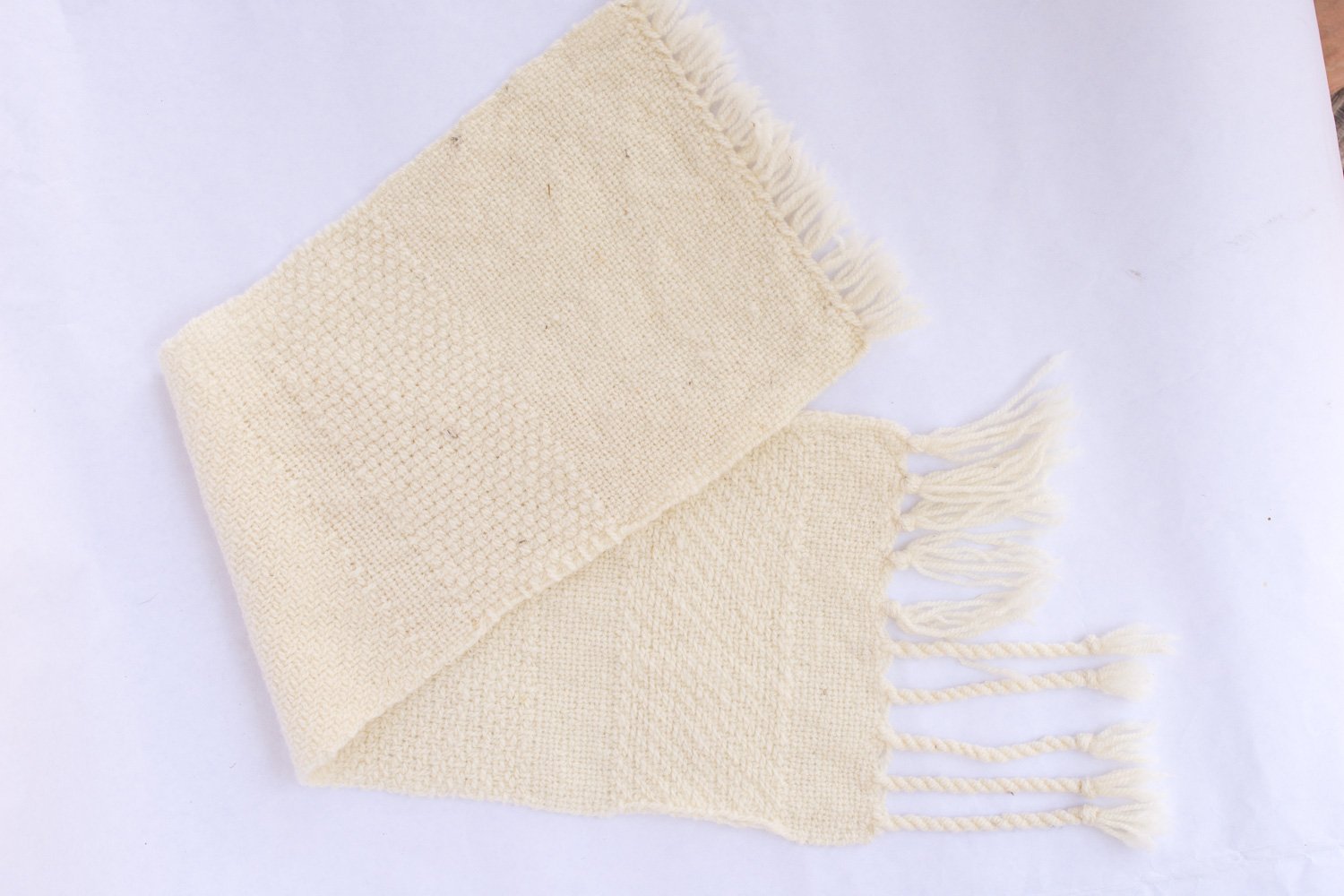
This is how it looks after wet finishing. I have worked with this yarn extensively and know to expect this outcome. So I sett the yarn appropriately.

This shows the difference in the yarn before and after wetting. The fiber doesn’t shrink, but the yarn relaxes and “blooms”. This is important to know when planning a project.

This shows the yarn in skeins. The one on the right has been soaked in water and allowed to dry naturally. This is off the topic of “beat” or “nudge” but it all affects the outcome of the project.

This warp is a mix of Jacob yarn and Timm Ranch yarn dyed with black walnut and mushrooms. It is sett at 6 epi. Notice how it looks loosely woven.

The warp was long enough for several shawls. The photo shows an unfinished and a finished piece. I wet finish large pieces in my old top loading washing machine. I put the fabric in hot water and detergent, agitate for usually 2 to 3 minutes, and then spin out the water. I remove the fabric to fill the washing machine with rinse water and then soak the piece briefly without agitating. I use the spin cycle to remove the water.
Here are a few more before and after examples of pieces I recently wove for my Shades of Black and White show at The Artery.

This is Jacob yarn sett at 8 epi. It’s important to nudge those yarns at 8 ppi to maintain the balance of the squares. If I beat harder I’d lose that pattern.

The finished scarf.

Close up of the pinwheel fabric.

This is another shawl using Jacob yarn. It was sett at 8 epi. Beat is 8 ppi.

This is after wet finishing (3 minutes of agitation). The fabric is thicker because the yarns have bloomed. It has a lot of drape and bounce. My notes show that draw-in (widthwise) and take-up (lengthwise) and shrinkage was 22%. So this started out at 25” wide on the loom and finished at 19.5”.

Here is another using Jacob wool. The details are similar to the previous one—8 epi and 25” wide on the loom. This design relies on alternating two dark threads and two light threads in warp and weft.

The shawl is 19” wide after finishing. This pattern behaved differently with 25% change widthwise and 18” lengthwise.
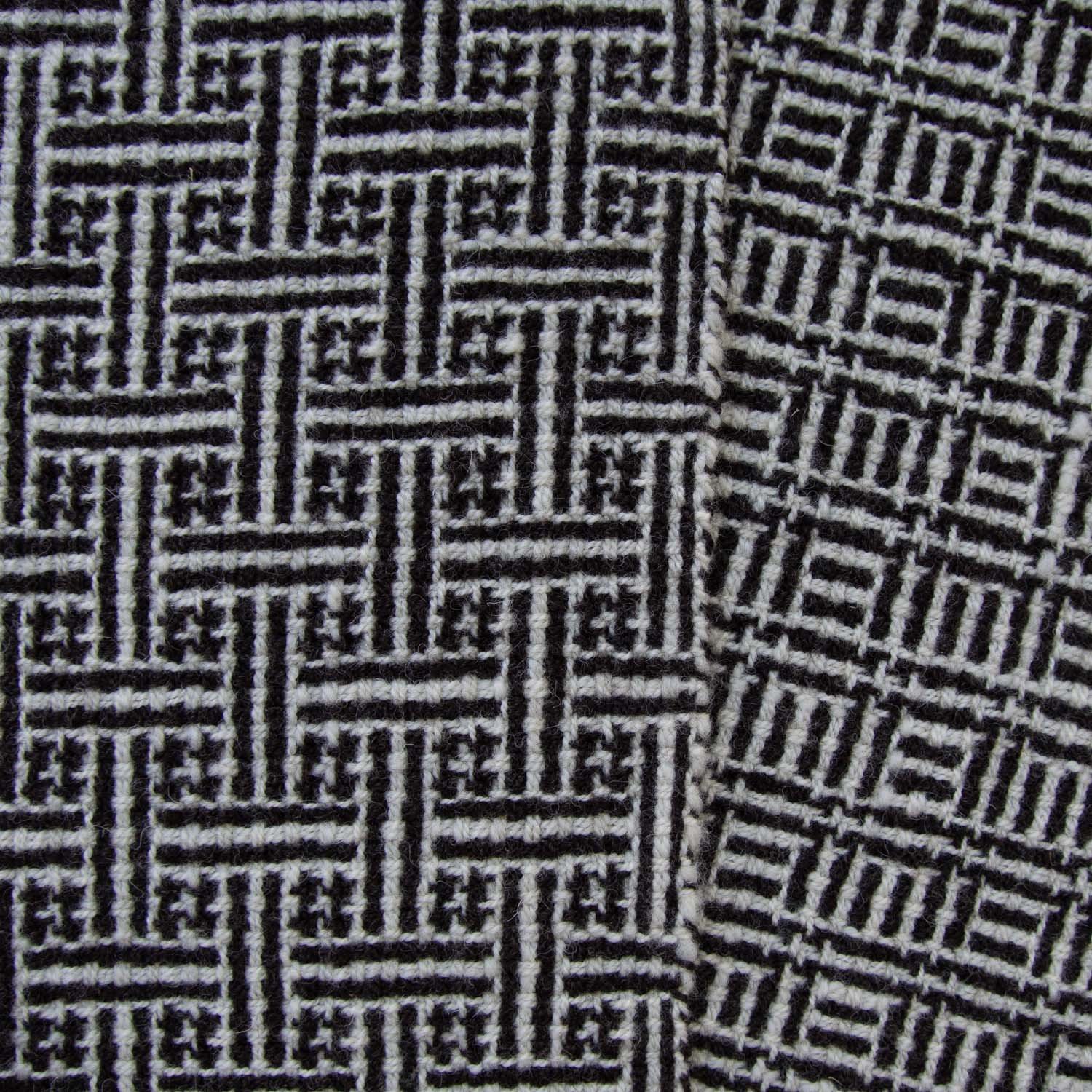
Here is a close-up of the fabric. I love the difference in the two sides of the fabric.

This is the last piece that I wove for the show. It uses the clasped warp technique, but on the floor loom instead of a rigid heddle.

I forgot to get a photo of this one before I set up the show so I took a quick shot at the Artery.
I wrote this blog post just after Shades of Black and White opened at the Artery September 30. Monday, October 24 is the last day. Some pieces have sold. Of those that have not sold, some will be incorporated into my space in the main part of the store and the others will go on my website or the Artery’s webstore. I thought I’d share some of my favorites.

This shawl is woven with my locally sourced Timm Ranch yarn except for the three black lines that are Jacob wool. It is a simple pattern, but time consuming. The design is woven on the loom as the weaving progresses.

This is another one. Only a small portion is visible at any one time so it’s a bit of a challenge to keep track of where those right angle designs are happening as you go. .

This was a favorite 8-shaft pattern in 100% Jacob yarn. It is relatively easy to thread and to weave. The two sides look very different.

This is a draft that will produce pinwheels or many other interesting shapes.
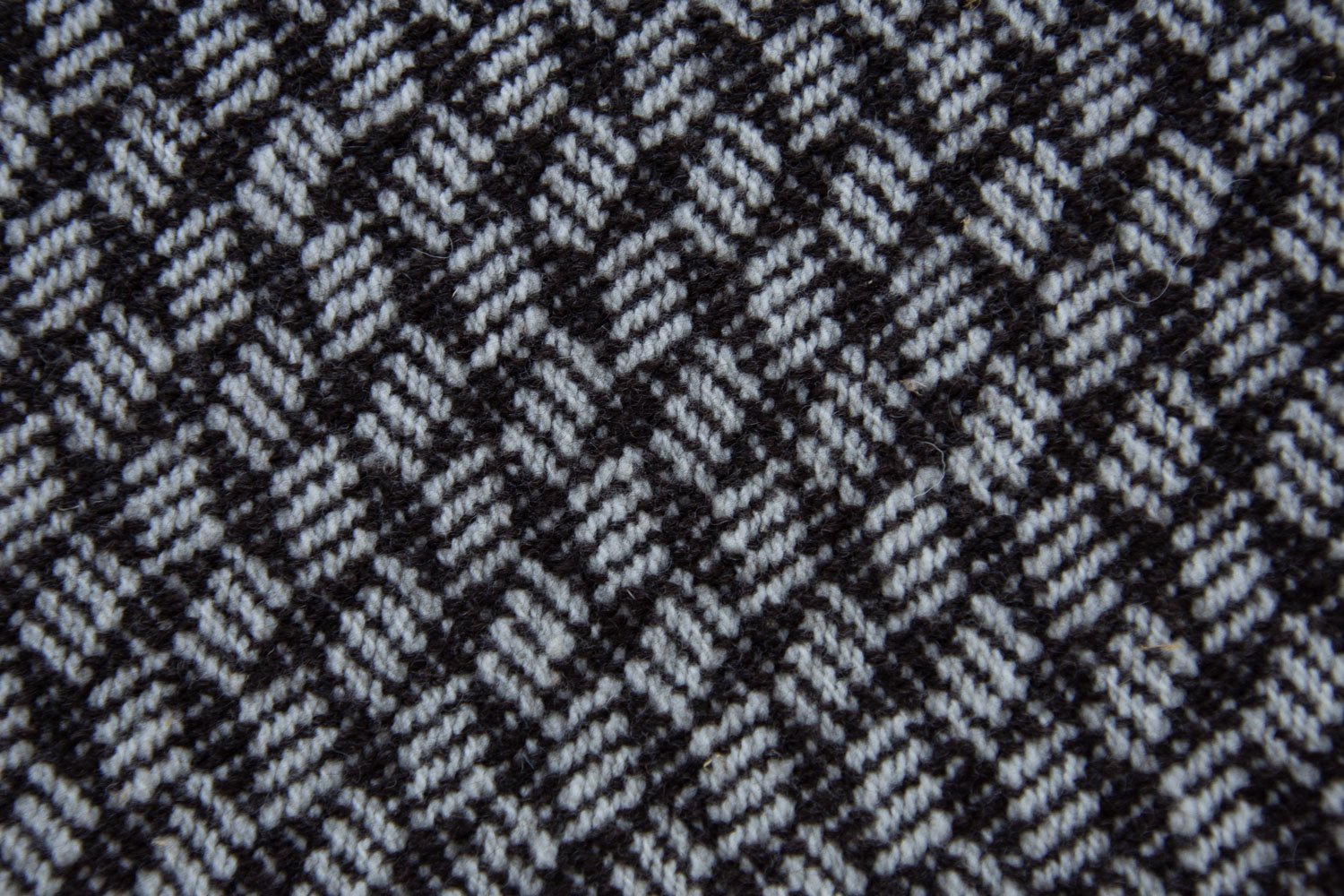
This is another favorite. I’ve always liked this tumbling blocks pattern. Jacob yarn on a Timm Ranch wool warp.

What about simple stripes? This is warped with alternating columns of 4 threads black and 4 threads white. The weave structure allows the yarns to open up when this is off the loom. Those stripes look like columns of beads. 100% Jacob yarn.
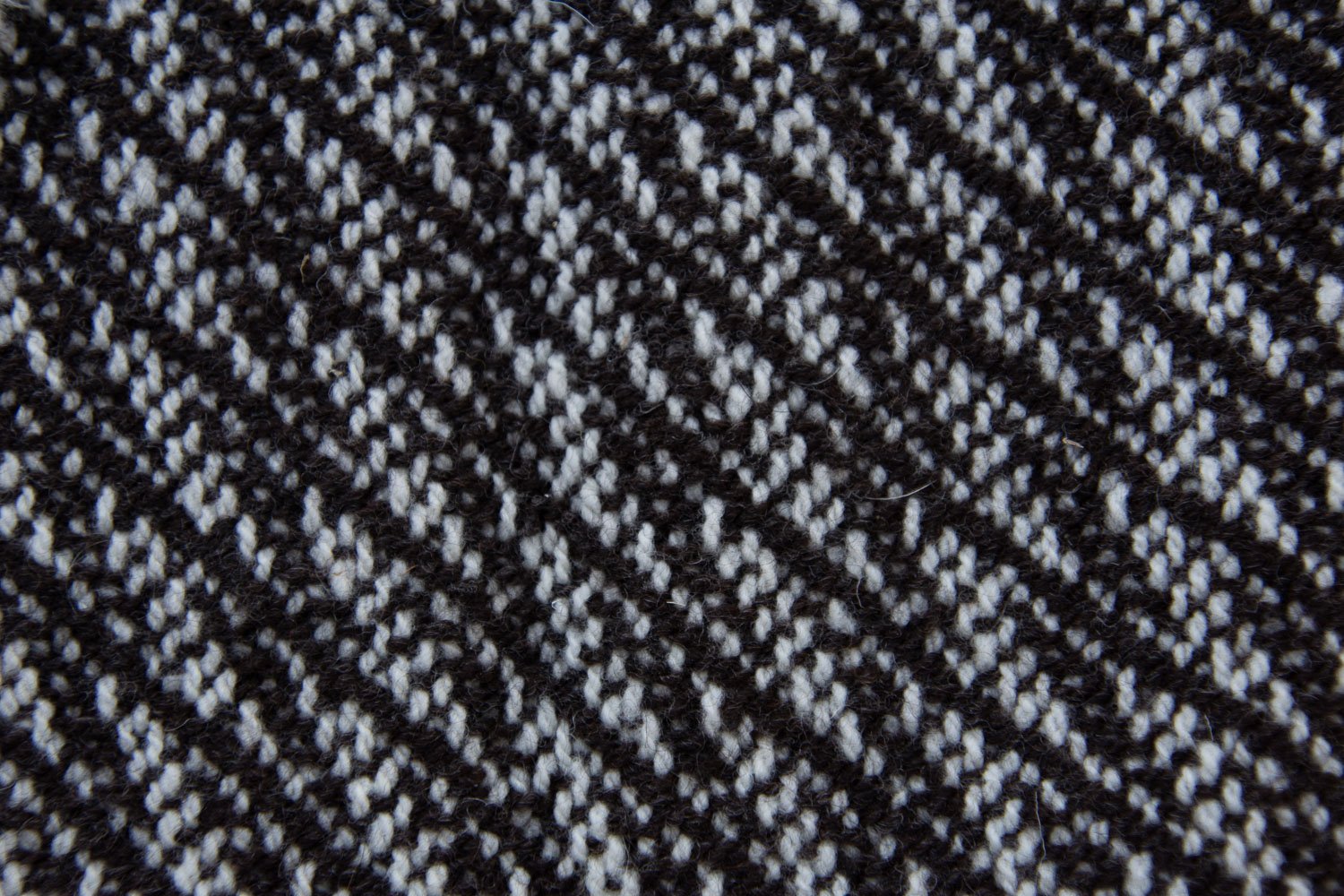
This was a new pattern for me and I like the movement in it. Jacob weft on Timm Ranch warp.
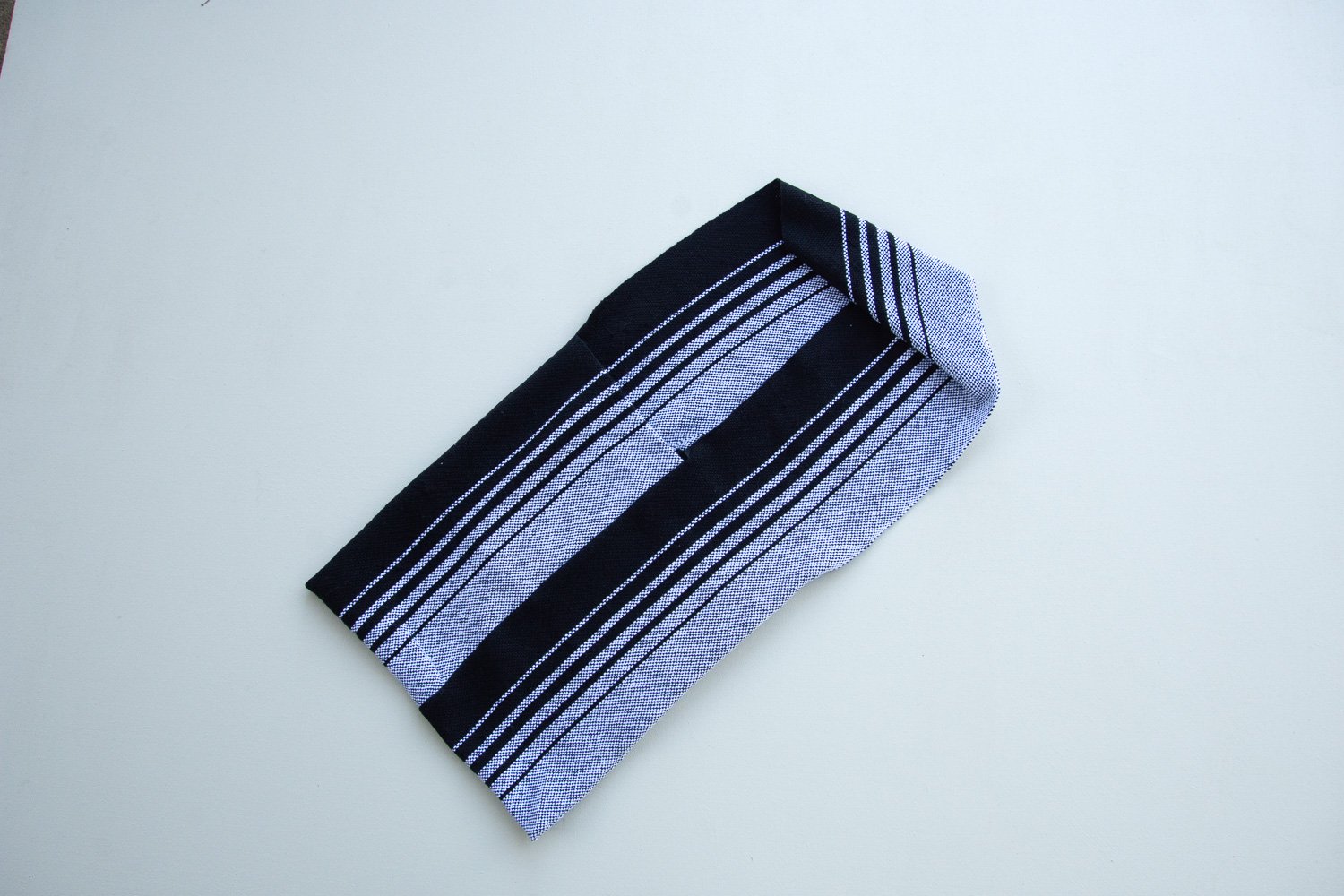
This is a bag woven of hemp. I didn’t find room for it in the show so it’s at home now. It will probably go on my sebsite.
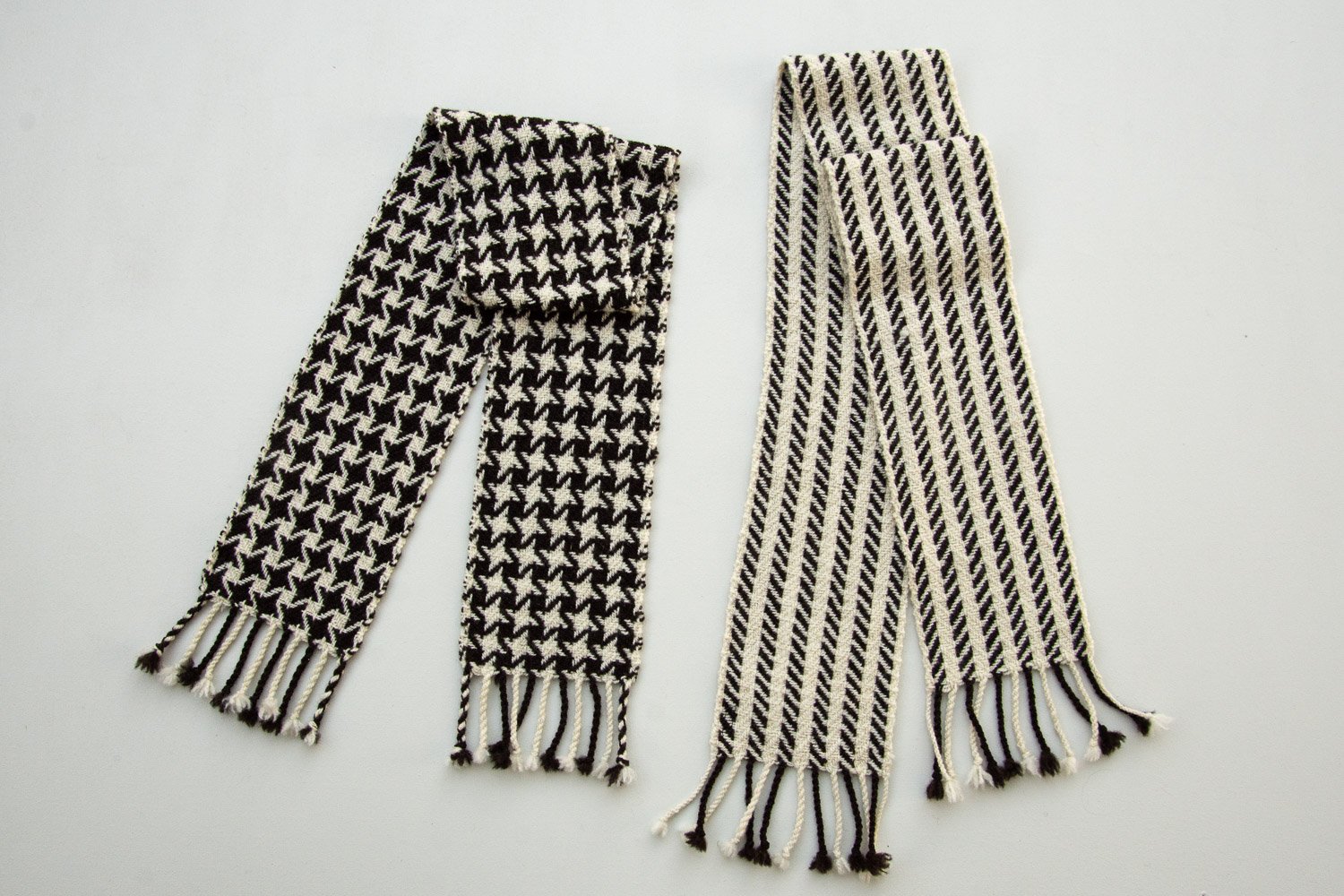
Another color and weave pattern. Both these scarves were on the same warp. They use 100% Jacob yarn.
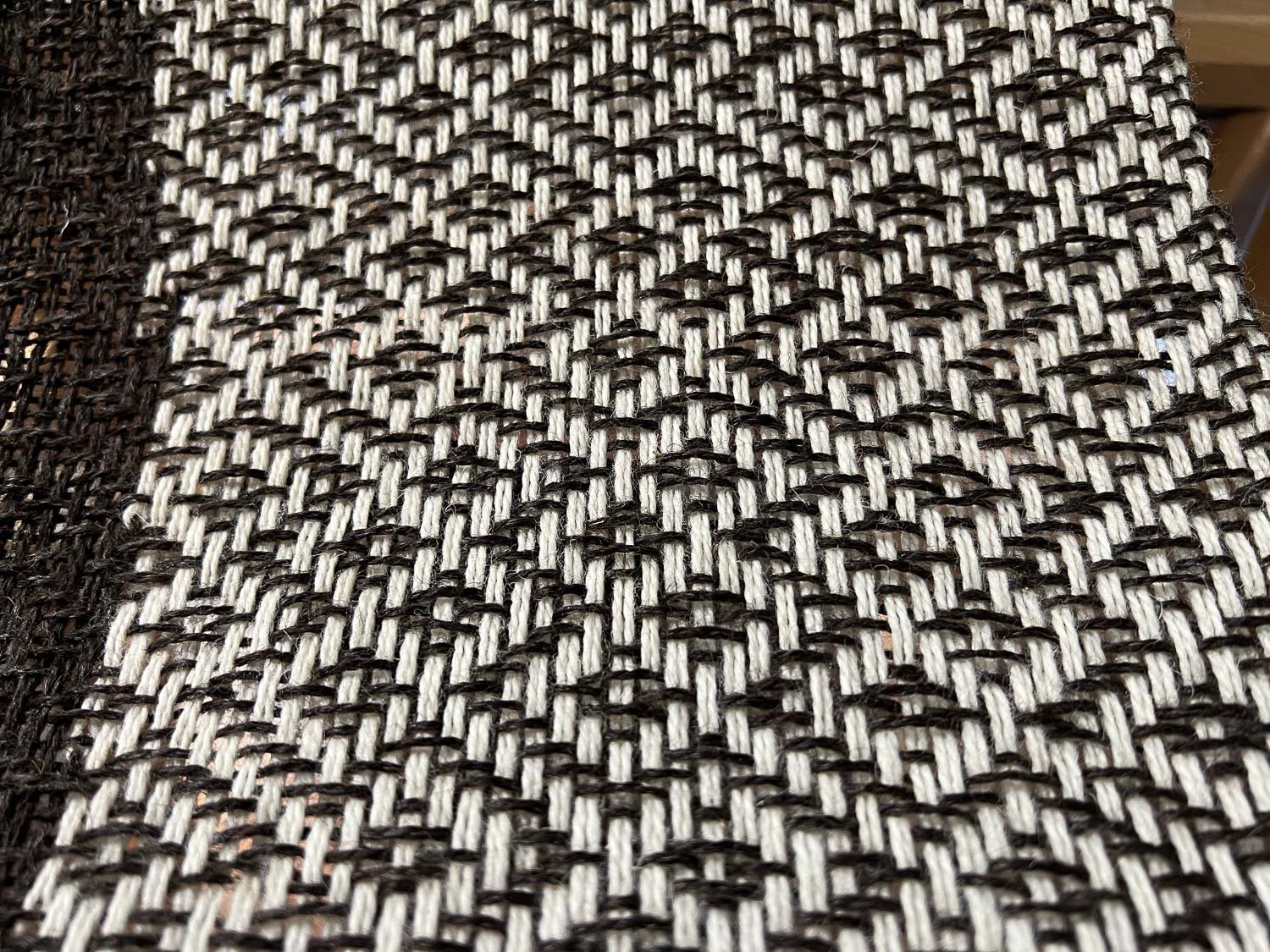
This is the last piece I wove—two nights before the show opened. I was talking to someone when the idea of Clasped Warp came up. I had planned to weave a clasped warp shawl, but forgot until now. I had enough time to put on a scarf warp. The photo below is after finishing.

The joined warp threads are placed in a diagonal line to almost the far end of the warp. This is 100% Jacob yarn.
This is the view from the south edge of the property.

That distinct line between green pasture and dried out plants indicates the difference between irrigating and not irrigating in the Sacramento Valley in the summer. For a variety of reasons parts of the pasture haven’t had enough water this summer. We had to start irrigating much earlier in the spring due to lack of rainfall, and that has an impact on how we spread out our water allotment through the season. Our water allotment is less this year than in the past. Our irrigation “system” isn’t as efficient as we’d like and it’s very difficult to get water to all the areas that need it.

This is the north end of that same paddock. This is dallisgrass that gets coarse and overgrown at this time of year and the sheep don’t keep up with it. They don’t want to walk through it. If you were a prey animal would you want to walk through grass that is over your head—how would you know if there is a lion lying in wait? The sheep are walking in a gap between the tall grass and where I set up the net fence.

They prefer to eat the more vegetative part of the grass and not the coarser stalks and seedheads.

This photo was taken from the road and there is a fence between the sheep and the grass in the foreground. They were on that paddock last and now are on the one with the taller grass. Their heads are down in the shorter grass and that tall overgrown dallisgrass is behind them.

The title of this post says Random Farm Photos. Here is the fleece of one of the ram lambs I have kept for this year. This is Meridian Rascal with fleece like his sire, Meridian Rambler.

When I fed the adult rams last night one of them didn’t show up. I saw Axis in the barn. He and Barrett were fighting the night before, but I guess they continued the squabble through the day. I hosed most of the blood off his head and sprayed fly repellant on him.

When I was in the barn earlier I heard the chirps of ground squirrels. These two were both up on the top of the fence around the ram pen. By the time I took the photo they were on the ground.

This is the seed pod of a plant called devils claw. The ones above are green and closed. When they dry out they open up and spread into claws with very sharp points. This is nasty stuff to find in a fleece. I dug this plant out and put it the trash. I don’t want it in my compost pile or the burn pile where the sheep have access.

I’m still working on weaving items for the show that I will put up next week. These are three blankets spread out to dry. That’s locally grown wool. The dark wool is Jacob.
This post is just what it says. I’ve taken so many photos with the intent to share them and tell a story, but then I don’t.

Sheep waiting in the shade. They come and go and are in the pasture even when it’s over 110 degrees like it was two weeks ago.

That’s a screenshot from my phone one of those hot days. I forget now how many it was in a row of over 100, but considering that some were over 110 it sure felt like a lot. Thank goodness that is over for now.


Two ram lambs that show a big difference in the spread of their horns. I’d like to hang onto both of these rams for different reasons. They both have good fleeces. The one with the wider horn spread is unrelated to most of the flock. The other is a shade of lilac (that brown/gray color of some Jacob sheep). If I can keep them for several months to a year it will be interesting to see how their horns look at that time.


Before I box and ship pelts for tanning I take photos so I have a record of what I sent and where I sent them. I have shipped 20 sheepskins in the last week or so. It will take from 3 to 5 months to get them back depending on where they were sent.
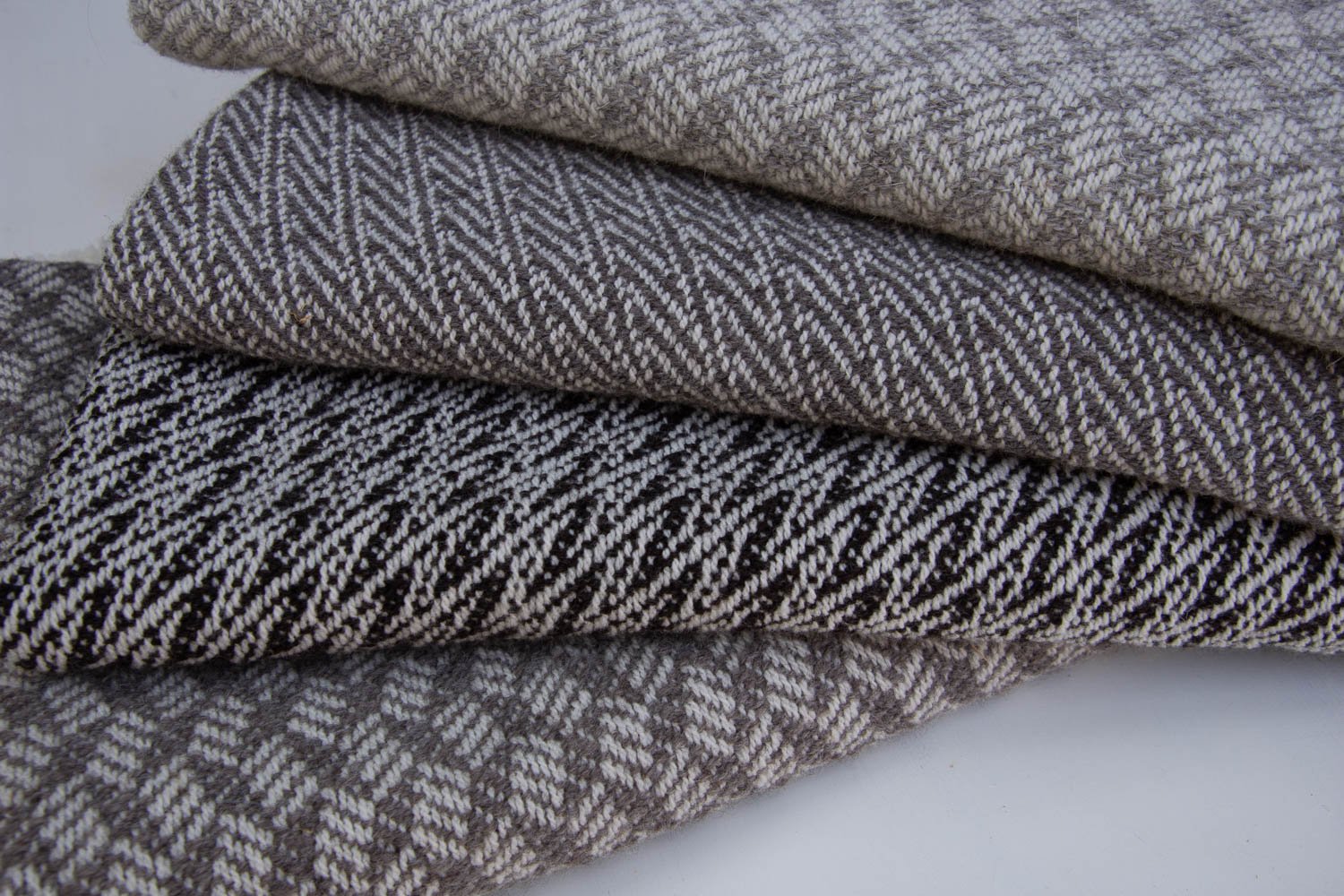
I’m spending a lot of time on preparing for the Shades of Black and White show that will be at the Artery for 3 weeks in October. In fact I will be setting this up the day before I set up my vendor booth at Lambtown. A lot going on. These are some of the latest blankets to come off the loom. These blankets use Timm Ranch wool warp and Jacob weft. They are very soft and I’m thrilled with both of these yarns this year.

This is Jacob wool warp and weft in progress on the loom.

This is how that fabric looks after wet finishing. I turned this one into a mobius shawl. The twist in it allows you to see both sides of the fabric at once. There is no right and wrong side.

This is where I left off tonight on a black and white Jacob blanket.

I was loading the truck today for tomorrow’s event and I heard a suspicious crackling sound across the “bamboo” fenceline that separates us from the neighbor on the north. (It’s not really bamboo, but an undesirable species, Arundo, although it makes a great windbreak for us.). I walked around the fenceline and into the next-door driveway. There was someone standing near the bushes on the right monitoring the fire. Still, with conditions so dry it’s a bit nerve wracking to see.
The neighbor on the west called me this afternoon to say that she saw smoke and called the fire department. They told her it was a permitted fire. I’m surprised that anyone was able to get a permit at this point. Let’s get some rain first.
Is it a continuing theme that I never have enough time to write blog post? Sorry if that is getting old. But it’s real. Here’s an attempt so that I can catch up with some of the photos I’ve taken and because I know that some of you do enjoy reading blog posts I write.

The first week of July I taught a Learn to Weave class. This is the students with their finished pieces.

Students learn all the processes to wind warp and weave off this sampler in two days.

In the meantime I’ve had a major custom weaving project hanging over my head. Normally I wind warps from cones, but this one was naturally dyed in skeins with no time to put the yarn on cones. Thank goodness I have a good swift—Schacht Ultra Umbrella Swift which I just put on the website now. The yarn winds from the swift to the AVL Warping Wheel to make 2” sections. More about this in another post when I get around to it.

This is 57 yards wound onto the sectional beam of my AVL production loom

This is after it is all tidied up. I have woven one so far, only 24 to go.

In between working on winding that warp I was trying to wet finish the last 20 blankets I took off the loom. Then they need to be measured and photographed.

These won’t go on the website for awhile because they are destined for a show at The Artery in October.

I have ignored my garden other than trying to keep a few things watered. A few plants are doing well despite my inattention. My Hopi Black Dye sunflowers are over 8 feet tall. I have had to prop up a few of them because they are getting so heavy.

Speaking of watering we are trying to keep the pasture irrigated but the irrigation district has reduced our allotment of water for the season. As we let the interval between irrigations get longer and reduce the time for each irrigation, we end up with less water and the field doesn’t fully irrigate. Those dry parts are what the Central Valley would look like without irrigation.

I have been conducting field trips for a summer camp through Trackers Earth. The kids spend time in the pasture, watching spinning and weaving and with sheep. Jade is always a favorite. She is an amazing sheep to let any number of people crowd around.
I don’t need any comments here about masks. I don’t think any of my blog followers would make those kind of comments, but when I posted a couple of photos on Facebook, I got nasty responses about children wearing masks. We are wearing masks in close spaces in the barn but not outside. I am selfishly concerned about my own health and missing out on some very exciting upcoming events. So that’s real life right now.

The most exciting thing going on is that my daughter and grandkids are visiting. That will deserve more blog posts. Kirby goes out with me every morning for chores. Jade is the favorite sheep and is always there for hugs and pets.

This is Kirby’s lamb, Rose, daughter of Belle, who Kirby showed at the State Fair as a lamb in 2019. Kirby will be at the fair to show Rose.
Just sharing what I see here. I have things on my mind now that will result in a future blog post. But these photos have been lined up for awhile.

This photo is from this morning after moving to fresh pasture. These paddocks on the east side are are looking so much better after being able to irrigate and then getting warm weather. We didn’t have nearly the normal winter time growth because there was so little rain. It also helps that Dan has been mowing after grazing to take down the stalky parts that are left.

It’s mostly about sheep here but the goats are photogenic. This is how I usually find the goats in the morning. Ellie and her daughter (mostly white) are together and Amelia’s daughter (brown) has now joined the pair because Amelia is distracted by this year’s kids.

Two of Amelia’s triplets that have decided the feeder is really a goat play structure.

This is what my dahlia garden has looked like for a month. The plants finally started sprouting and then they were attacked. I don’t know what is getting them. I put out rolled up newspaper to see if earwigs were there. I put out a game camera (only for one night though) to see if I could catch ground squirrels in action at night. I have sprinkled diatomacous earth around. I don’t know if that is helping but some of the plants look better. The funny thing is that we have this one bed and there are big tractor tires at each end with more plants growing in them. The ones in the tires aren’t eaten as much—does that mean there is some creature that won’t cross the rubber tire?

Speaking of bugs I was sitting outside talking to my daughter on the phone and I noticed movement on the ground. There were dozens (hundreds?) of these bugs.

I checked iNaturalist and Google and I think they are boxelder bugs. They are under the maple trees and locust trees. Maples are listed under the description for these bugs. I have never noticed them before so maybe its something about this year or its just that I don’t usually just sit under a tree and do nothing else. These are redder than the ones I see in the photos but I think it’s because they are the juveniles. When I looked later I found ones with more brown on the back.

This is a selection from my recent ecoprinting. They are for sale in Davis at the Artery and on-line on my website and the Artery website.

This is the AVL loom before I threaded. That’s 50 yards of wool for a custom weaving project.

Its hard to make out the pattern while I’m weaving because the value of the warp and weft are similar and it’s a very open weave structure. After wet finishing the yarn will bloom, the holes will disappear, and the piece will look more like a blanket.

That is about 15 blankets woven so far. After they come off then I need to cut them apart, trim all those threads, and look for errors to fix. Then I need to do it all over again for another 20 blankets.
This is a post with no theme other than the snippets (is that a word?) of all the stuff I’ve been doing.

I got my second batch of the 2020 Jacob fiber back as yarn. The first batch of 2020 wool was spun at Valley Oak Mill and is listed here. This batch is from Mendocino Wool Mill and is listed here. It always take me a little while to figure out how to best present it for sale. I had some put on cones and some in skeins. The yarn on the cones appears to be so much finer than the skeined yarn but it’s the same yarn—it is just under more tension when wound on a cone. I wondered how much the skeined yarn would bloom when washed. That information is important to know when you are planning a project. Whether you are going to knit, crochet, or weave with the yarn you need to know what will happen to the piece when it is washed.

I washed a white and a black skein to see what would happen. In this case washing just means soaking in hot water and then hanging to dry. This is four skeins of yarn. Can you tell the difference in the yarns on the outside and in the middle? The middle ones have not had any treatment. The outside skeins have been washed and the character is very different.


One way to measure the change is by looking at wraps per inch (wpi) before and after. In this case the black yarn measured 14 wpi before washing and 10 wpi after. If you don’t allow for this post-washing change then you may be surprised at how the finished piece looks and behaves. I will wash all the skeins before labeling them.

Another test before selling the yarn is how it actually works in use. I wove scarves of each batch of yarn to compare them and to determine the best sett (spacing of the yarns on the loom). I tried each at 8 epi (ends per inch) and 10 epi.

I photographed these so that the light was behind and you can kind of see the spaces between the yarns. Those spaces are nothing like when the scarves were still on the loom with the yarn under tension. When you cut the piece off the loom the yarns relax and they further relax and “bloom” when fulled in hot water. This photo shows 2 scarves from each batch of yarn at 2 setts each. All four turned out great and even though the yarns appear different, it’s hard to tell the difference in these finished pieces. I look forward to using these yarns in some much larger projects next.
By the way I put these scarves on three different websites—here on my own, on the Fibershed Marketplace and the Artery webstore, all the while carefully keeping track of which one is where so I don’t take a chance on double-selling them.

Another project I’m working on is recording some videos for the Learn to Weave class using the rigid heddle loom. I am going to teach this on Zoom next week and I want videos for students to refer to when we’re not on Zoom. I warped the rigid heddle loom with all four of those new Jacob colors and wove a short scarf while recording most of it. I haven’t wet finished the scarf yet, or edited the videos. (Thanks for reminding me.)


I also finished another v-shawl. This is another thing on my list of things to do. I want to put together a kit for this shawl and give options for the stripe design. I’ve woven several. I just need to get the instructions put together and figure out the best way to present it. I just added this shawl to the Artery web store along with one of the pinwheel scarves.


I still have a barn full of fleeces. I spent some time yesterday working on those. I only have two full fleeces listed on the website so far, but I have listed several 1-pound batches for people who would like to start with raw wool but not start out with a whole fleece. I am skirting, sorting, and photographing. Raw wool is listed here.

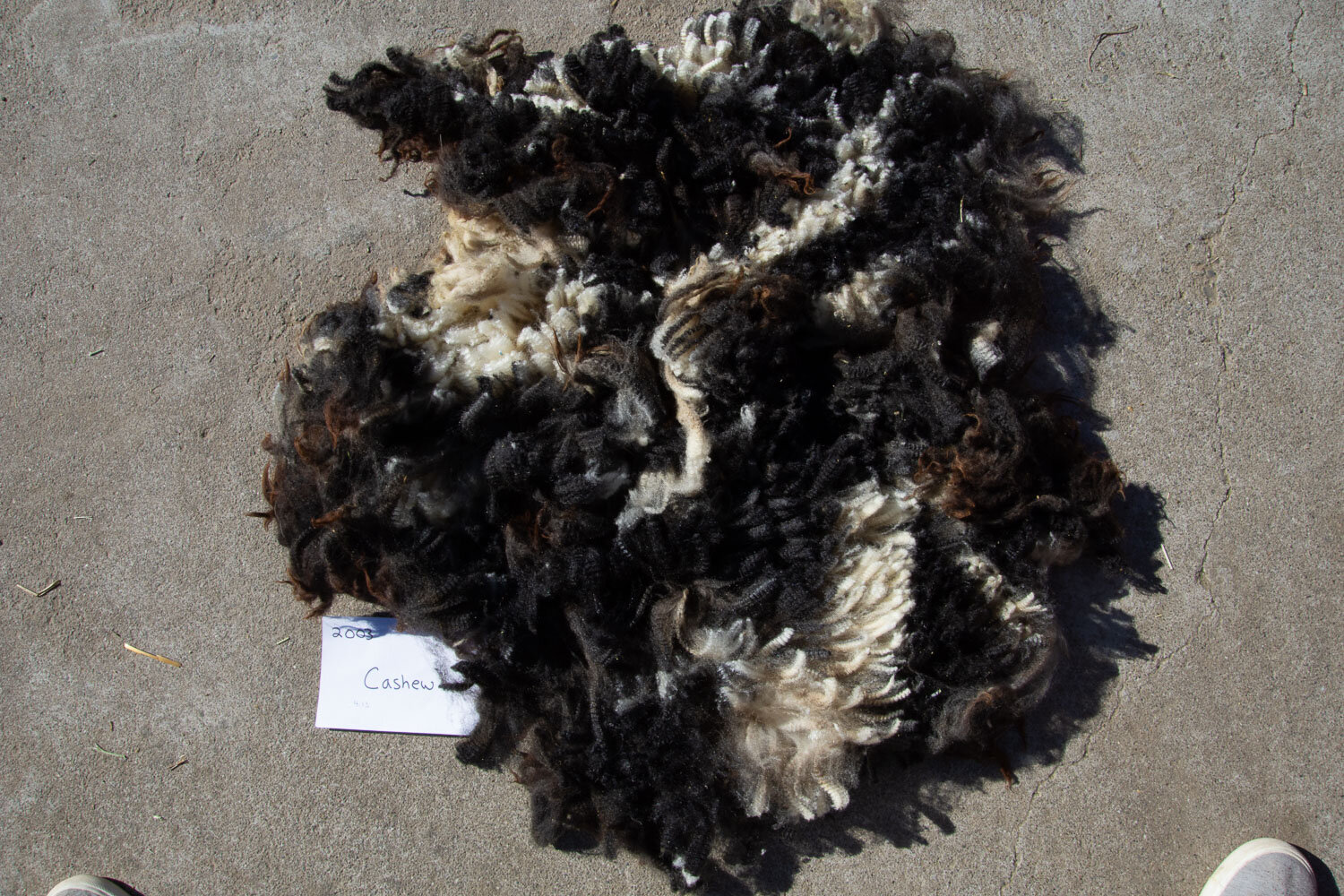
Here is another example. In the meantime I want to get my hands in this and start working with it myself. There are some really gorgeous fleeces here.

I said this was a bunch of random photos. So far it is all about wool and weaving and the things I need to do. So let’s get random. Dan saw me weaving and my weaving slippers reminded him of the Bernie mittens that have been popping up all over the internet.

How about springtime flowers? It’s not spring yet, but the daffodils are here.

So are the almond flowers.


I don’t usually have the patience to scour the wool in locks even though it would save a lot of time at the other end of processing. I pulled out some locks that had more VM (vegetable matter) than I would like. I’m going to see how clean I can get them with flicking after washing. That will go much faster if they are already organized.

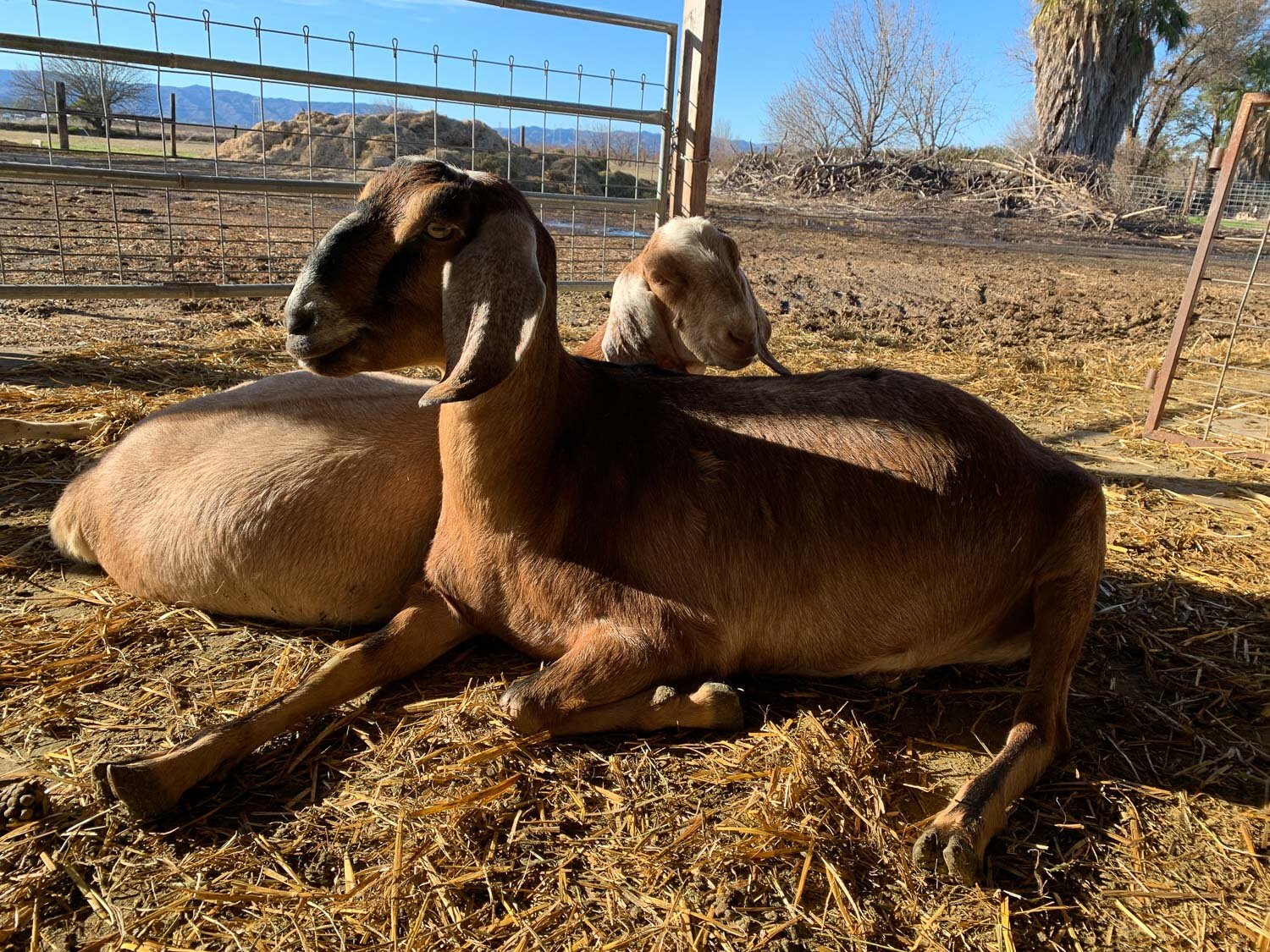
How about some goats? These are mothers with last year’s daughters. That’s Ellie and her daughter on the left and Amelia with hers on the right. Amelia is pregnant again.

One last random photo. The redbud is going to bloom soon. Hope springs eternal! And we’re getting our Covid vaccines Monday—have to drive an hour for it but I finally tracked it down.
Display and sheep-to-shawl demo at the UCCE Hopland Barn to Yarn in May, 2019.
Read MoreAt Meridian Jacobs farm we raise Jacob sheep and sell locally grown wool fiber, yarn, and handwoven goods. We teach fiber classes and sell Ashford, Clemes & Clemes, and Schacht spinning and weaving equipment. We encourage farm visits with field trips and our unique Farm Club.
Search blog posts since 2019. If the search says it can’t find a post try putting in your search word a second time. I don’t know why but the second time it seems to work.
Search the entire website, including older blog posts.